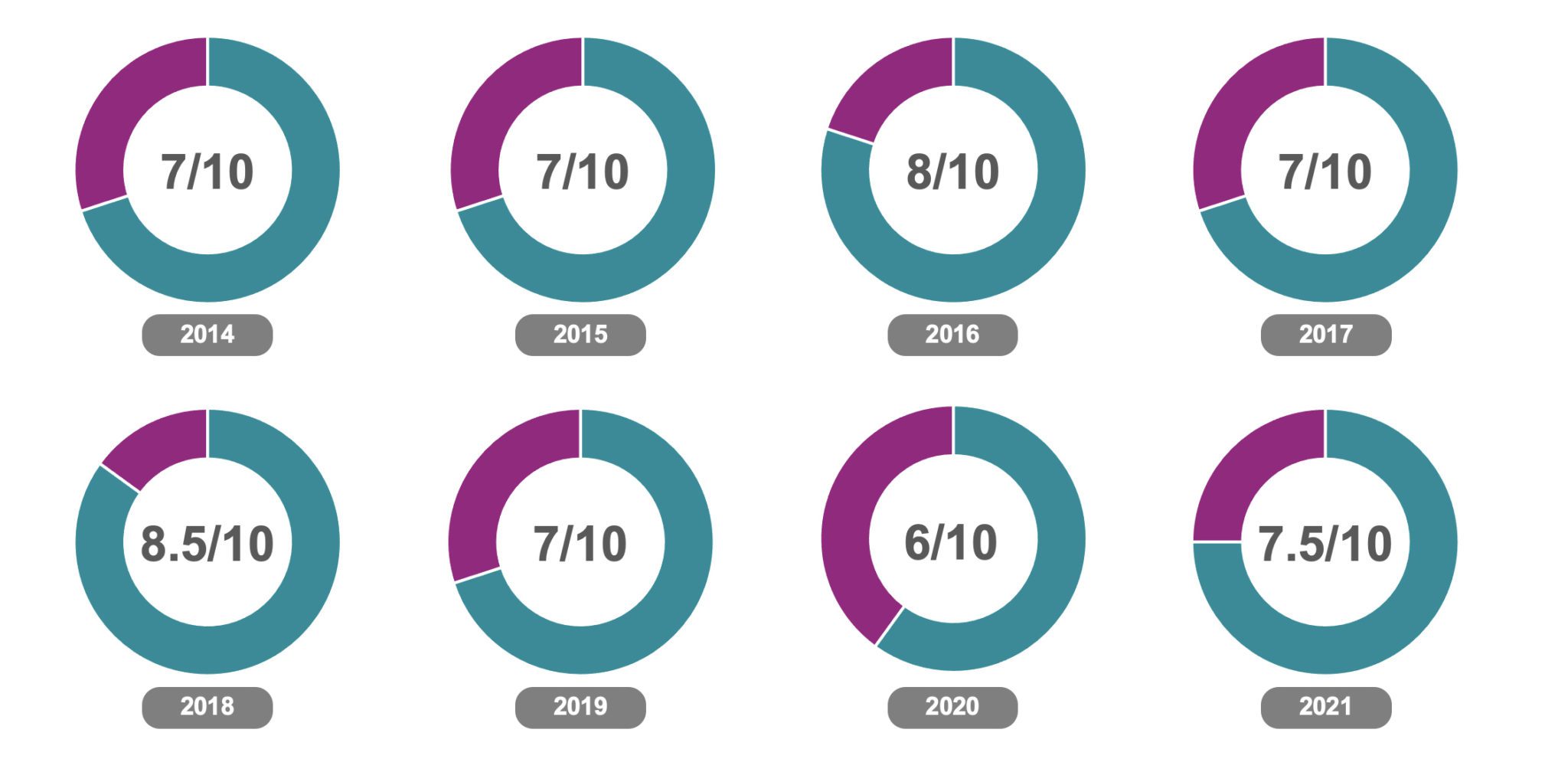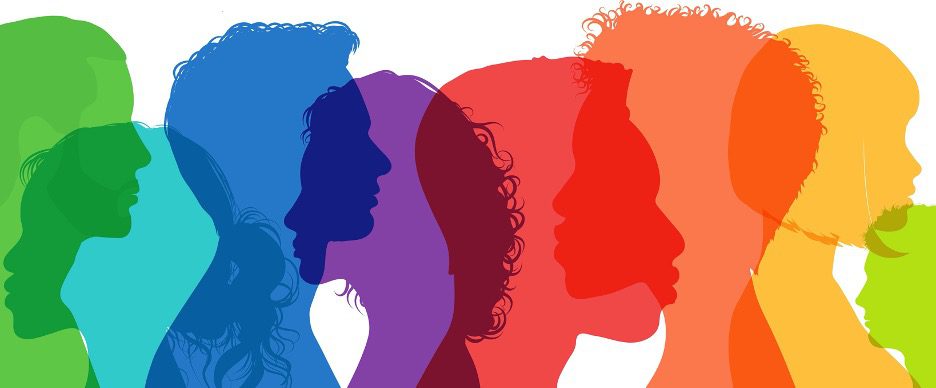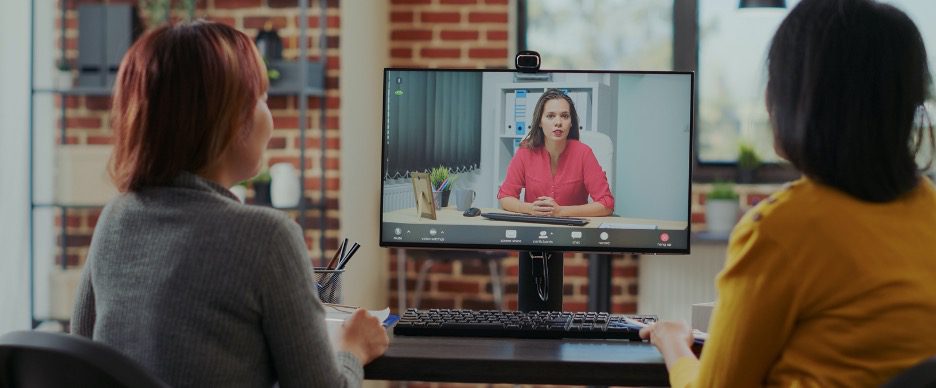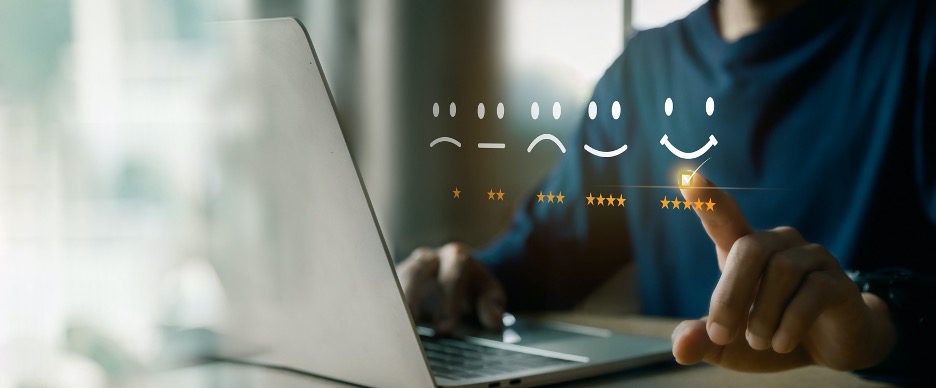DWG’s 2023 predictions for the digital workplace
by Nancy Goebel
It’s hard to believe it’s that time of year again! It’s November and that means Digital Workplace Group is abuzz with planning for the year ahead – our 2023 research, our year-end member survey, our calendar of events… and it also means it’s time to announce our 2023 predictions for the digital workplace.
So, why have predictions?
We are in close contact with our members, technology providers and practitioners in our wider circles. We see digital workplaces in action via our benchmarking. We explore ‘what good looks like’ throughout the year via live tours, our research programme, our podcast, and our day-to-day advisory activities. These things in combination give us a vantage view of what’s going on in our industry circles.
We are often asked to share what’s hotting up. The predictions give us a platform for unlocking reflection, comparison and ambition. I often like to say that DWG is part connector, part knowledge broker and part coach. The predictions give us a powerful launch point for all three types of conversation.
Let’s start with a quick look back.
For those of you who may be new to DWG, our industry predictions, or both, Paul Miller, DWG CEO and Founder, launched the digital workplace predictions back in 2014; before that he had shared predictions for the world of intranets. On average, Paul’s predictions have achieved a success rate of 70%, or 7 out of 10. There have been a couple of standout years, such as 2018, when his predictions hit an 85% success rate. Not too surprisingly, the low came in the height of the pandemic when priorities suddenly pivoted, resulting in a 60% realization rating for the 2020 predictions.

Last year, Paul Miller and I collaborated on the 2022 edition of the predictions. With input from a mix of practitioners and DWG colleagues, I gave us a 7.5 out of 10 for 2022:
| Prediction 1 | Dynamic working will pave the way for a new breed of hybrid leaders. | ✓ |
|---|---|---|
| Prediction 2 | The physical world of work will remain in a midlife crisis. | ✓ |
| Prediction 3 | Innovation will be revitalized by citizen developers. | ✓ |
| Prediction 4 | Digital connections will foster meaning and belonging – to help spur recruitment and retention. | ✓ |
| Prediction 5 | Business intelligence (BI) will finally have its coming of age in the digital workplace. | ✓ |
| Prediction 6 | Advanced digital workplaces become critical infrastructure, ready for the ‘next disruption’ to work. | ✓ |
| Prediction 7 | Microsoft Viva will be the best thing since sliced bread in the ‘hybrid culture wars’. | ✓ |
| Prediction 8 | Future of Work units find their feet, spanning digital, HR, facilities and strategy. | ✓ |
| Prediction 9 | Networked learning will become a 4D experience in the digital workplace. | ✓ |
| Prediction 10 | Knowledge Management takes centre stage (again), combating the exodus of insight caused by the Great Resignation/Great Migration. | ✓ |
How does this compare?
In early November, I shared the 2022 year-end review in addition to unveiling the 2023 predictions. No one challenged the scoring, but it was fascinating to see how strongly members reacted to two things:
- The lack of universal support around the embedding of knowledge management because of the ‘distractions’ caused by the Great Resignation, quiet quitting and the hybrid conundrum (#10); and
- A widely held belief that Microsoft has a very powerful marketing machine and is still a long way from delivering on the promise of Viva (#7).
On the road to 2023!
1. The digital headquarters moves into steady-state evolution while employers and employees continue the hybrid working tug of war.

During the pandemic, the digital workplace became the essential workplace. It has become embedded as a key aspect of wide-ranging resiliency plans designed to enable work to carry on functioning regardless of major weather, political, wartime and health events. We’ve since seen organizations that embrace a digital-first mindset take a further step still – such that the digital workplace has become the digital headquarters inside such organizations.
The challenge to solve now is how these digital headquarters and the physical workplace will co-exist in a more meaningful and flexible way. There is an active tug of war happening between what employers want relative to returning to the office versus knowledge-based employees, who want the flexibility to decide where they work on any given day.
Many organizations are still struggling with getting the balance right for hybrid working. This period of experimentation will continue well into 2023, as employees keep up the pressure only to have to come into the office for meaningful conversation, connection and collaboration.
2. Digital inclusion goes well beyond accessibility basics.

We saw a level of authenticity enter the work setting as the pandemic unfolded and, with that, came a wider definition around what digital inclusion means for organizations: We bring our whole selves to work, and work needs to be a place where everyone feels like part of the organization, regardless of where they are sitting on any given day.
For a long time, digital inclusion focused largely on a narrow slice of accessibility basics. As many organizations have evolved from proprietary software development to ‘best of breed’ digital workplaces, there’s now an even greater expectation that we will provide digital spaces for all. This means much more than just providing integrated assistive technologies (e.g. real-time transcription, screen readers), moving on to ensure that the connections, conversation and work that happen within digital spaces truly embrace the broad mix of cognitive, language, cultural, wellbeing, identity and other important considerations that will allow people to express themselves more fully and so to deliver their best work.
And, based on the ongoing role of hybrid working, organizations can attract a wider and more diverse pool of people because they’re not as constrained by location when recruiting new talent, whether this be for entry-level or mid-career hires.
3. The metaverse is the new digital archipelago of workplace experiences.

Another area that’s sparking a lot of questions is the metaverse.
In simplest terms, think of this as the next incarnation of the internet – but using augmented and virtual realities. It’s still early days for usage within the digital workplace, although not new to avid gamers.
Metaverse adoption is, so far, greatest in high-tech and professional services industries; however, we are beginning to see pockets of experimentation in other industries as well. For that reason, I am couching the metaverse as the archipelago of digital experiences.
Facebook was the first to set a flag branded Meta in claiming its island, but there are many more to explore. Organizations like Avanade are experimenting with new ways to connect with their employees, with applications to date including meeting, learning and recruiting experiences (as shared in episode 109 of Digital Workplace Impact entitled How the metaverse is changing Avanade’s workplace. Sticking with the island metaphor, you can think of the metaverse as a cluster of islands.
There are still many islands that are as yet undiscovered. Ones to watch will be the use digital twins of testing and improving products, processes and facilities in the metaverse before adopting in business. Few applications are already in use in manufacturing, urban planning, healthcare and hotels.
It’s still early days for digital workplace applications of the metaverse, so we will see more pockets of testing and learning well into 2023.
4. The most important skill for digital workplace teams will be navigating change. Enter wayfinding powered by psychodynamics.

If we were to roll the clock back 10-12 years to the early days of the digital workplace, we would see that the heavy lifting for digital workplace teams centered around designing and building apps, intranets, and portals. Often those were multi-year endeavors that required complex planning, staging and deployment. 90% of the effort was about standing up the technology.
Nowadays, we come into the office and there is a new version of something that changed virtually overnight within our digital workplaces. That’s both the beauty and the challenge of working with cloud-based solutions and software-as-a-service.
The implication is that digital workplace teams need to be experts in helping people find their way as change unfolds – both planned and disruptive. Not only does that mean operating as continuous learners but also helping others understand, accept, and embrace change on scale on a rolling basis – that includes stakeholders, leaders and employees at large.
A key to this is enhancing digital workplace teams’ change management toolkits to couple wayfinding know-how with psychodynamics. People not only need to understand what’s changing but also how it supports what they are doing – and why. They also need to be motivated to act or make decisions. A missing ingredient has been helping people move through change by understanding their emotions, motivators and unconscious patterns of behaviour.
5. Recruitment, on-boarding and ‘early days retention’ will require business-specific digital spaces mixed with in-person connections.

Another important focus area is looking at the talent pool across recruitment, onboarding and retention. What’s concerning within that purview is that one half of new hires fail – and there has been countless research around this. The issue is one that was exacerbated by pandemic because many new hires had to figure out how to navigate a new organization from home.
When you translate this into the cost of attrition to an organization, it can be upwards of 2 to 2.5 times the cost of salary for that pool of new hires.
Many organizations have plans to fix their end-to-end recruiting, onboarding and early-days retention efforts to support a more effective search and enculturation process through the first six months of employment. Key to this is getting the right balance between the virtual and in-person experiences in building lateral connections, team collaboration, leadership access, corporate context and working knowledge of how to get things done. The corporate aspects represent onboarding and the business aspects represent inboarding. The two need to work in tandem with guided experiences not only for the new hire but for the hiring manager as well. This latter has been a blind spot in the process for many organizations to date.
6. HR will claim stewardship of the employee experience at large; digital workplace leaders need to bring their passion for connections, curiosity, and experimentation.

Closely tied to the previous prediction is that we’re also seeing human resources sharpen their strategic focus around people and culture transformation. As part of CHRO’s (heads of HR) taking on a stewardship role around the employee experience. That is not just from a digital workplace perspective. Rather it is a wide scope around looking at the future of work with long-term hybrid working as an anchor tenant.
So, if digital workplace needs to help their organizations with wayfinding as the pace of change accelerates, what should see from digital workplace leaders?
Well, digital workplace leaders also need to really harness their passion for connection, curiosity, and experimentation.
- Connection: Helping HR to work alongside all the other stakeholder groups to further reduce friction points across functions and processes to deliver end-to-end experiences as new technologies like AI and the metaverse take hold.
- Curiosity: Reinforcing the need to be continuous learners and to cultivate an environment in which the ‘why’ questions can be asked, in order to: inform courses of action; understand the impacts; seed new thinking and approaches – and share the story along the way, as shared understanding feeds the curiosity loop.
- Experimentation: Helping HR and others to become comfortable with the idea that we test, we learn, we fix and we move forward. Experimentation is a natural part of a creative process and building that into the culture of hybrid working will be even more important as we step into the future of work.
7. ESG programs will pressure digital workplace teams to clean up their act. It’s time to start addressing your dirty ecosystem.

Jack Amend, the co-founder of Web Neutral Project, says: “The internet is essentially the largest coal-fired machine on the entire planet.”1
Environmental, social and governance (ESG) investing is used to screen investments based on corporate policies and to encourage companies to act responsibly – and in 2023 we will start to see a new level of conversation around ESG within the workplace.
Many Chief Digital Officers already have plans in place to measure, track, reduce and offset the carbon footprints of their external digital properties.
So… if the customer experience is enabled by the employee experience, it stands to reason that it’s just a matter of time before your organization’s ESG leadership knocks on your door to ask about your levels of content pollution and the carbon footprint of your internal digital workplace properties! Better still, why not proactively approach your ESG team to get that conversation underway.
Like humans, data emits carbon. And, according to Gerry McGovern, 90% of data is rubbish and is out of use within three months of creation. Does your organization really need those 15 employee profiles? And do you need them for all four enterprise social platforms? How many of those 1,500+ communities have gone quiet? Need I say more?
Also, think about the energy required to power all those devices used as part of hybrid working. In time, the cost of disposal will also become a factor. ‘When will you start putting emissions data in the hands of your employees and leaders via the digital workplace?’ is likely to be follow-on question from your ESG leader.
Pick the carrot or the stick. Either way, it’s time to clean up your dirty ecosystem.
And, while you are chatting with your ESG leader, why not also instigate a conversation about eco-anxiety – something employees are feeling due to the ongoing energy crisis. How will you support them via your digital workplace?
8. Digital workplace teams will be challenged to show continued impact. Meaningful metrics will be essential.

Looking at the carbon footprint of the digital workplace (prediction #7) is just one aspect of measuring impact. Recessionary and inflationary pressures are straining budgets, so digital workplace teams now more than ever need to show tangible impact on employee experience. Central to this is understanding what meaningful metrics need to be in place in order to understand both how to manage the digital workplace day to day and target the highest and best use of investments to ensure value for cost.
Going beyond vanity metrics has been a long-standing challenge for digital workplace teams. Thankfully, we are starting to see technology providers take a more proactive approach to not only capturing more meaningful metrics but also thinking about the visualizations. The combination is important to ensure the right actions by looking at a mix of efficiency, effectiveness, sentiment and other metrics that matter.
Importantly, versions of these metrics are also in the hands of employees via the likes of Microsoft and other tools, so employees, teams and leaders can better understand the information needed to guide their workday. The first wave has been to look at whether people have enough focus time to plan, prioritize and execute daily work. In time, those insights will expand to measure a wider scope.
9. AI capabilities will leapfrog a broader definition around productivity, and Microsoft is showing us that digital coaching will come at a premium.

Artificial intelligence (AI) is another area where digital workplace teams are increasingly experimenting. You might find it surprising to hear that AI will leapfrog a broader definition around productivity.
Typically, we’ve looked at productivity impact, but employees are now being asked in addition to share how they feel about their productivity levels alongside the hard measures – meaning that the definition of productivity now looks at both ‘the what’ and ‘the how’ of work.
We’re starting to see the likes of Microsoft and other tech companies build in a smart set of nudges and prompts that will add up to digital coaching around driving productivity and effectiveness. Based on what we’ve seen coming out of Microsoft Ignite 2022 and other tech conferences, these more advanced levels of advice and support, designed to take our performance collectively to the next level, will be priced to the premium.
10. Innovation scale with the help of digital assistants.

One consequence of hybrid working is that knowledge workers are spending more time in meetings than pre-pandemic. I can’t tell you how often I hear people say that they are often double- or even triple-booked throughout the day.
Organizations will face new pressure to rationalize volume and efficacy of meetings, to allow headspace not just for reflection and planning but also to innovate. It is only by creating performance capacity that employees can be freed up to create new things (be they products or services) alongside making things better, cheaper and faster.
Microsoft and others in the tech space are hyper-aware of such needs. And, throughout 2022, they’ve been encouraging and enabling:
- ongoing use of meeting-free days
- work sprints that focus on innovation and learning
- headspace moments that nudge us to make time for mindfulness, self-check-ins, reflection, focus-time and virtual commutes
- enabling inspiration libraries to instigate fresh ideas.
What’s next? Advances that help shift the process of innovation from reliance on happy accidents and serendipity to a curated collection of digital assistants that spark aspiration, reinvention and inspiration. In combination, areas will include targeted digital nudges, prompts and coaching that help us tap into unexpected connections, context-sensitive learning and collaboration support, designated spaces for creative play, actionable ideation centres, and expanded low-code/no-code capabilities for solutions development.
To make this feel more tangible, I’m thinking along the lines of the Amazon model, which is constantly analysing our patterns of behaviour as a route to suggesting another item for us to consider, inspiring us based on actions taken by others, helping us to make connections to related products, or reminding us to come back to something we were thinking about earlier. When you add these individual elements together, you are taken on an intelligently crafted journey, designed to ‘help’ you try new things and come back for more.
Bringing it all together with a super prediction.
The digital workplace gets a home, a heart, a brain, and courage – Welcome to the land of Oz!

Looking at the predictions in combination, I found myself thinking about one of my favourite childhood films. Having moved from the black-and-white days of the pandemic, we’ve now stepped into colour vision. The digital workplace has landed in Oz.
We still have a way to go before we arrive at the Emerald City, but we’ve discovered that the digital workplace has…
- A home: We started with the idea that the digital workplace is the digital headquarters for many organizations today.
- A heart: We are creating spaces to welcome new hires and foster wider employee experiences that allow us to bring our whole selves to work while supporting more authentic leadership through connection and conversation.
- A brain: The metaverse, AI and meaningful metrics will play important roles in helping to make sure we can immerse ourselves in new experiences, access the right information, make better informed decisions and use data to help get our best work done.
- And courage: And this is all happening at a time when change is moving with velocity. It takes courage for digital workplace leaders and their teams to be continuous learners, connectors, curiosity-minded people, experimenters and wayfinders in a sea of change.
Footnotes
1 Your website is killing the planet (Wired, 2021)
2 Your Content Has a Carbon Footprint … and It’s a Problem (Reworked, 2022)
Categorised in: Accessibility, Artificial intelligence and automation, Change management and adoption, Digital employee experience, Employee experience, HR, Metrics & measurement
